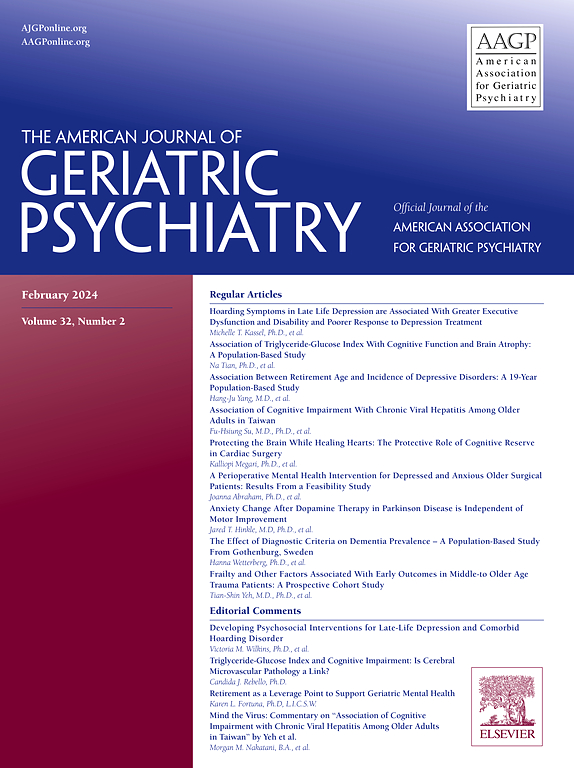33. USING NOVEL WEARABLES AND ECOLOGICAL MOMENTARY ASSESSMENT TO TRACK PHYSIOLOGICAL BIOMARKERS IN PSYCHOTHERAPY FOR LATE-LIFE DEPRESSION
IF 3.8
2区 医学
Q1 GERIATRICS & GERONTOLOGY
引用次数: 0
Abstract
Introduction
Late-life depression is common, debilitating, and linked with poor mental health and medical outcomes. Individuals with depression experience high baseline heart rates and sleep disturbances, including fluctuations in circadian rhythm and sleep cycles. Depression is typically measured using weekly or periodic interviewer-rated or self-reported measures. These scales are limited by recall bias and low time sensitivity and accuracy, especially among older adults. Novel wearable devices and real-time mood scales measured multiple times a day (ecological momentary assessments; EMAs) can improve the precision and accuracy of depression severity measurement. There is little work on the application of these methods in the aging population, with only a few studies examining changes during treatment for late-life depression. We aimed to examine whether wearables and EMAs are feasible and can track precisely the changes across multiple domains during psychotherapy for late-life depression
Methods
We implemented a novel wearable biometric ring (Oura Ring) and EMAs (measured twice daily) in an ongoing randomized controlled trial of psychotherapies for late-life suicidality. Three patients with major depression and suicidality completed 9 weeks of psychotherapy while wearing the Oura Ring and completing two EMA surveys a day (afternoon and evening surveys). Oura Ring data collected daily measures of average heart rate (beats per minute), heart rate variability, and hours of sleep. EMAs measured number of hours they slept, negative affect (stress, anxiety, irritability, depression, and loneliness), and positive affect (energy, motivation, excitement, interest, and satisfaction).
Results
Our preliminary results show that all three participants experienced a reduction in negative affect and an increase in positive affect during psychotherapy. There was variability in trajectories of positive affect: Patients A and C showed a pronounced increase in positive affect, while Patient B showed an initial increase followed by a decrease. Further, for all three participants, hours slept (measured by Oura Ring) and self-reported hours slept followed a similar pattern over time, indicating these two measures may be linked. Finally, Patients A and C showed a consistent increase in heart rate variability, while patient B experienced a decrease over time.
Conclusions
Our preliminary case studies suggest that integrating wearables with daily EMA self-reports can provide a feasible, precise, and granular assessment of daily changes in affect and biometrics, such as sleep and heart rate, during psychotherapy for late-life depression. The strong alignment between wearable-measured and self-reported sleep data, along with observable trends in heart rate variability and negative valence mood responses, highlights the powerful potential of these methods. This potential is particularly evident in their capacity to enable real-time, more personalized monitoring of treatment progress. Furthermore, these methods can potentially identify warning signs of deterioration or alternatively identify therapeutic gains during treatment.
33. 使用新型可穿戴设备和生态瞬间评估来跟踪心理治疗中晚年抑郁症的生理生物标志物
老年抑郁症很常见,使人衰弱,并与不良的心理健康和医疗结果有关。抑郁症患者会经历高基线心率和睡眠障碍,包括昼夜节律和睡眠周期的波动。抑郁症通常是通过每周或定期的访谈者评估或自我报告来测量的。这些量表受到回忆偏差和低时间敏感性和准确性的限制,特别是在老年人中。新颖的可穿戴设备和每天多次测量的实时情绪量表(生态瞬间评估;EMAs可以提高抑郁程度测量的精密度和准确度。这些方法在老龄化人群中的应用研究很少,只有少数研究考察了治疗老年抑郁症期间的变化。我们的目的是研究可穿戴设备和EMAs是否可行,以及是否可以精确跟踪老年抑郁症心理治疗过程中多个领域的变化。方法我们在一项正在进行的老年自杀心理治疗随机对照试验中实施了一种新型可穿戴生物识别环(Oura ring)和EMAs(每天测量两次)。3名患有重度抑郁症和自杀倾向的患者在佩戴Oura Ring的同时完成了9周的心理治疗,每天完成两次EMA调查(下午和晚上的调查)。Oura Ring数据收集了每日平均心率(每分钟跳动次数)、心率变异性和睡眠时间。EMAs测量了他们的睡眠时间、负面影响(压力、焦虑、易怒、抑郁和孤独)和积极影响(精力、动力、兴奋、兴趣和满意度)。结果我们的初步结果表明,在心理治疗期间,所有三名参与者的消极情绪都有所减少,积极情绪有所增加。积极情绪的轨迹存在差异:患者A和C表现出明显的积极情绪增加,而患者B则表现出最初的增加,然后下降。此外,对于所有三名参与者来说,睡眠时间(由Oura Ring测量)和自我报告的睡眠时间随着时间的推移遵循相似的模式,表明这两种测量可能是相关的。最后,患者A和C表现出心率变异性的持续增加,而患者B则随着时间的推移而下降。初步的案例研究表明,将可穿戴设备与每日EMA自我报告相结合,可以提供一种可行、精确和细致的评估,以评估晚年抑郁症心理治疗期间情绪和生物特征(如睡眠和心率)的日常变化。可穿戴设备测量的睡眠数据和自我报告的睡眠数据之间的强烈一致性,以及心率变异性和负价情绪反应的可观察趋势,突显了这些方法的强大潜力。这种潜力在它们能够实现实时、更个性化的治疗进展监测方面尤为明显。此外,这些方法可以潜在地识别恶化的警告信号,或者在治疗期间识别治疗收益。
本文章由计算机程序翻译,如有差异,请以英文原文为准。
求助全文
约1分钟内获得全文
求助全文
来源期刊
CiteScore
13.00
自引率
4.20%
发文量
381
审稿时长
26 days
期刊介绍:
The American Journal of Geriatric Psychiatry is the leading source of information in the rapidly evolving field of geriatric psychiatry. This esteemed journal features peer-reviewed articles covering topics such as the diagnosis and classification of psychiatric disorders in older adults, epidemiological and biological correlates of mental health in the elderly, and psychopharmacology and other somatic treatments. Published twelve times a year, the journal serves as an authoritative resource for professionals in the field.

 求助内容:
求助内容: 应助结果提醒方式:
应助结果提醒方式:


